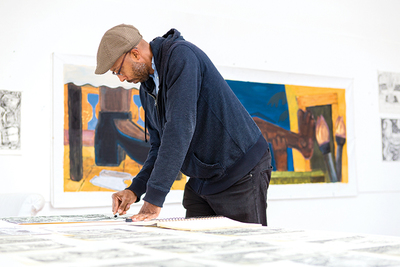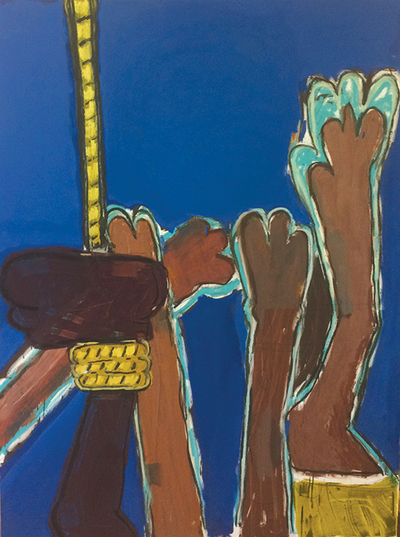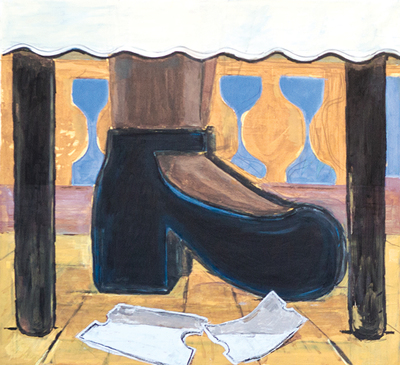Enrico Riley

Enrico Riley working in his Rome studio. Photo: altrospaziophotography.com.
As the videos showing African-American men dying at the hands of police were released, artist Enrico Riley happened to run out of his vivid chromatic paints, and his work took a new direction. It was a moment for him and our country; the ongoing conversation about color, race and representation had been amplified.
Over these last three or four years, Riley’s work has shifted from somewhat surrealist to gestural, specific scenes that address issues that are “really sticky, really complicated.” He began painting images of violence—such as a lynching, in Untitled: Black Bodies, Infinite Receptors—that he never thought he would paint, he says on an unseasonably chilly July day in his Lebanon, NH studio. The painter, professor and father of two cites the 2014 death of Eric Garner, an African-American dad who died in police custody in New York, as his “emotional tipping point.” “Whether you like it or not,” he says, “The things you are thinking about will show up in your work.” Garner’s death coincided with him running out of bright cadmium paints. In his earlier works, his figures were often boldly colored—cadmium red, bright green, black or blue. Many of these earlier figures were portraits in a noncontextualized background. Without his usual palette, yet still wanting to paint, he began to work with the earth-toned paints he had around. He painted a figure diving into a pool with gun barrels pointed toward him. “I think it was a sienna color—and the figure automatically had a racial identity, just from that one slight shift,” he says. “I had to come to terms with, and understand that now I was making paintings that were dealing with race.”
Riley, 43, speaks with a quiet intensity. He comes across as serious and thoughtful, yet when his smile finally breaks through, it is warm and genuine. He’s an associate professor of studio art at Dartmouth, his alma mater, and an award-winning artist, receiving a Guggenheim Fellowship in 2008. He is freshly back from Rome, where he spent ten months painting and drawing at the American Academy as a recipient of the Rome Prize. In Italy, he found the historical infrastructure and drier landscape inspiring for his art. Speaking very limited Italian, he says he was able to
take in his surroundings less verbally and more visually.
One painting he worked on in Rome during the presidential election, Untitled: Respect, has the shoes and legs of a dark-skinned woman in a ballot box, framed by a curtain. On the golden wooden floor, there is fallen paper—perhaps ballot stubs or enlarged hanging chads. The woman’s legs look sturdy in her wedge heels, as if she is taking her civic duty seriously in a way her grandparents were prevented from doing.

Enrico Riley, Untitled: Black Bodies, Infinite Receptors, 2015, 60 x 48″. Photo: Molly Zapp.
The son of a mother who immigrated from Jamaica and a father who is from the Northeast, Riley was born in Connecticut but grew up in Richmond, VA. He says he wants his art to engage viewers in ways that might not be easy. “I want people to think about race in our society, and I wouldn’t be making these paintings if I didn’t,” he says. “I want people to be thinking about violence inside of the African-American community, about violence amongst humans in general. The question for me is, how do you paint about it in a way that takes into account how complicated those issues are?”
That his works are gestural helps Riley avoid being didactic or heavy-handed, though certainly his work is intense and appropriately challenging for viewers. Sometimes it’s difficult to tell if the body parts depicted in his paintings are hands or feet, but that they are the splayed-out or tied-up limbs of a person of color in a dangerous situation is clear. In Untitled: Flagellation, False Confession, a red-toned arm is shown hanging from a rope. A light-skinned arm holds a black baton that is hitting the arm of the person who is tied up. In the background is an achingly beautiful sky—cerulean and cornflower with touches of navy. The painting serves as a reminder that people choose to inflict violence under clear blue skies, and that suffering occurs in picturesque places—beauty and brutality are not always confined to separate spheres. It also showcases the sickening physical intimacy between the bodies of the people involved in acts of violence. Untitled: Midnight, Hunting, appears humorous at first glance, as the viewer’s eye first goes to the backside and tail of a white dog against an olive green fence. But then the rest comes into focus: a gun barrel, two black hands, and a brass instrument on the other side of the fence. Even the perception of the dog shifts: Are canines a beloved part of the family, or an animal used by authorities to police you?

Enrico Riley, Untitled: Respect, 2016, oil on canvas, 53 x 49″. Photo: Molly Zapp.
Riley says that he draws nearly every day, and that his drawings serve as the beginnings for his paintings. He says he’s been thinking about the works of Goya, Philip Guston and the Italian Baroque painter Artemisia Gentileschi as historical antecedents to his work. Riley has been experimenting with new media works that combine visual art and sound, as well. In Rome, he met and started collaborating with the Stanford University-based classical composer Jonathan Berger, also a recipient of a Rome prize. They began their current project, I Can’t Breathe, with similar ideas in their minds. (“I can’t breathe” is the sentence Eric Garner uttered as he was dying in a police chokehold.) Riley started to make drawings based on close listenings of Berger’s music, and Berger, in turn, composed music in response to Riley’s drawings. A video work of this project will be shown at Stanford this fall, and a live musical performance, along with the visual art, will be performed there in October.
Riley says that some people find his art extremely emotional, but these depictions of vulnerability are central to his work. “I think it’s important for us to remember that we are vulnerable…and to periodically, or even more than periodically, remember that we can be made vulnerable very quickly,” he says. His art serves as a powerful reminder that American beauty, struggle and brutality often exist in the same view.
Molly Zapp writes about American culture. She lives in northern Vermont.
